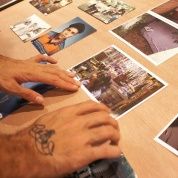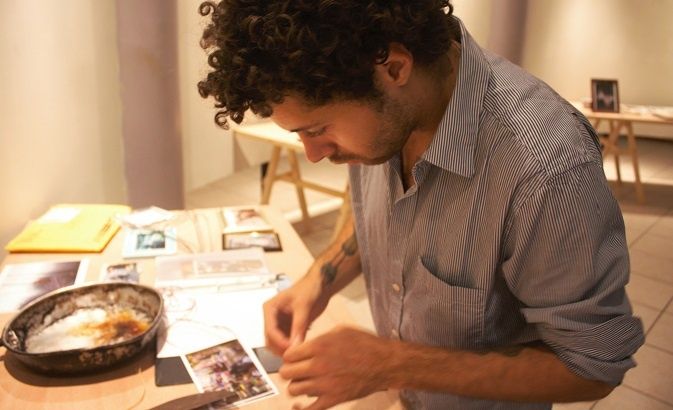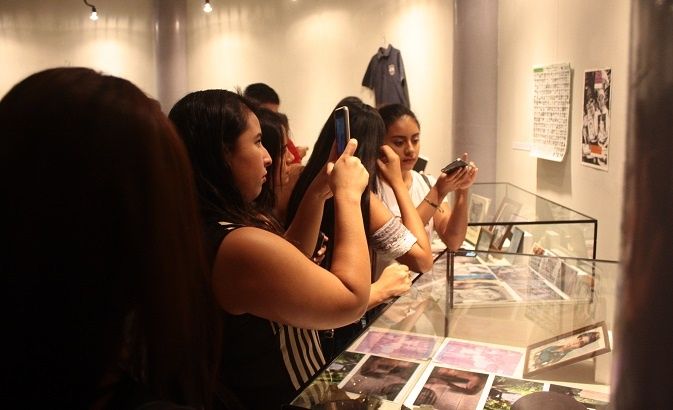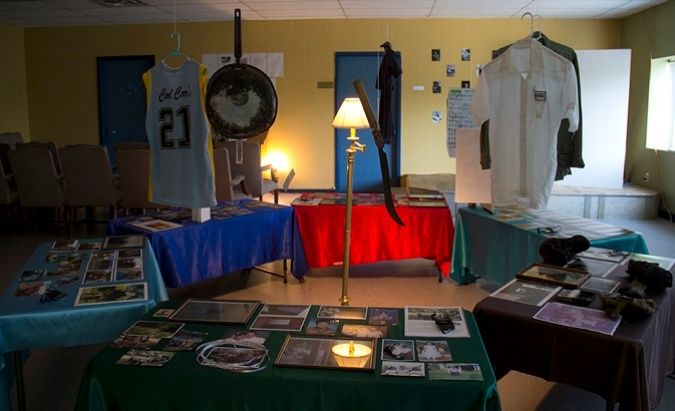One of the moments that I remember most since I began this project in 2015 was during an interview with Julio, who’s in his early 40s.

Julio was around seven or eight when he and his family, and about 200 other Salvadorans were rounded up and led to a wide, fast running river, the Amatitánt, the night of August 21, 1982.
There’s never been a definitive body count, but experts estimate the Atlacatl Battalion, a U.S.-trained Salvadoran security force executed about 200 civilians at close range in the day at what’s now known as the El Calabozo Massacre.
Julio was the only one in his family who survived the shootings. He lost his older brother and his father.
He took me to a house he had lived in as an orphan, then we went to his home and had dinner with his wife, Dina, and his young daughter.
I interviewed Dina. I asked her how she thought the war has affected Julio. She responded that Julio has a hard time tell her and their daughter that he loves them.
Dina said it wasn't because he didn't love them, but because Julio had watched the military kill his family. She said the experience was still traumatic, palpable. After the massacre he was shuttled between different homes. He never really learned to give love in the ways a person is supposed to.
That conversation made me realize that the consequences of war are not just political or social, “they're also incredibly personal,” Sayre Quevedo told teleSUR
Quevedo is the creator and artist behind Re:Construcción, a multimedia exhibit on display at the Eastern Regional Museum in Santa Ana, El Salvador until January.

Sayre Quevedo Setting up Re:Construcción exhibit in Santa Ana, El Salvador. Credit: Ernesto Bautista
Re:Construcción, an interactive exhibit, displays the audio interviews of survivors of the Salvadoran civil war, 1980-1992, along with their photos, handwritten letters, household items, religious symbols, military uniforms, trinkets - things that remind them of and help them move past their war experience.
The U.N. reports 75,000 people were killed during the 12-year conflict that began in 1980 between U.S.-backed Salvadoran military and the leftist Farabundo Marti National Liberation Front, or FMLN, guerrillas who wanted land reform and liberation from the repressive military government. Another 30,000 Salvadorans are still disappeared. The vast majority of war crimes go unconvicted.
Re:Construcción visits themes of memory, transnational identity, intergenerational knowledge, the societal effects of conflict, and healing in El Salvador and for El Salvadorans who fled to the U.S. to continue their lives.
The entire exhibit consists of three parts. The first part is 6 tables, each telling the story of an individual of family who lived through the war. They feature an ex-soldier, a former guerrilla fighter for the Farabundo Marti National Liberation Front, FMLN, a priest, a war refugee who lives in the U.S.
Quevedo himself forms a part of the subsequent Salvadoran war diaspora in the United States.
He was born in San Francisco, California in 1992. His mom’s parents fled there a few years before the war officially started in 1980, as state violence was on the rise.
The military had already started killing civilians by the hundreds prior to the official start of the war. In 1978 just over 680 civilians were shot or killed, and in 1979, 1,796.
RELATED:
Hundreds of the Americas' 'Most Violent Gangsters' Arrested
Quevedo’s mom was born in San Francisco, but ran away from home when she was 15. He says she never felt safe returning to her parent’s, so “I never had the opportunity to meet that side of my family or understand my family history.” His dad left the family before he was born in 1992.
In the Fall of 2015, Quevedo was a sophomore at The New School in New York City pursuing a degree in global studies and journalism. He began to research the Salvadoran civil war, hoping to get closer to his family history, when “the rates of unaccompanied minors from Central America” detained by the U.S. border patrol was rising “dramatically.”
It was also the year El Salvador’s murder rate became the highest in the world - 6,656 in a population of roughly 6 million.
Quevedo says he felt that the histories of the war and the “contemporary issues I was reading about in the news (about El Salvador) were deeply interconnected.” He received a university grant and went to El Salvador to interview people about the impacts of the past war and present-day violence.
Two years later these interviews became Re:Construcción.
Quevedo admits, “While I'm not any closer to understanding my family's history I feel much closer to the Salvadoran and Central American community than I ever have before.”

Visitors taking pictures of Re:Construcción exhibit in Santa Ana, El Salvador. Credit: Ernesto Bautista
The documentary artist tells teleSUR, “I feel honored to have had the opportunity to have conversations with people, young and old, about their experiences with the conflict, with migration, and their identities. ... I held people when they cried and got to be present in a little bit of their healing.”
Part two of the exhibit, he explains, is an “interactive wall” that Salvadorans in country and in the U.S. can add to with their “own objects, drawings, writings, and perspectives on the impact on the war for themselves or the Salvadoran community at large.”
Re:Construcción is a traveling exhibit that will move across the “United States and El Salvador” where he hopes the wall will be added to for “new perspectives.”
RELATED:
Human Rights Commissioner Zeid Raad Al Hussein Visits El Salvador
Since last August, the exhibit has been displayed in Long Island and Brooklyn, New York, Washington, D.C., Maryland, and Los Angeles. Sayre and his collaborators always exhibit in regions with large Salvadoran populations. This is the first time they have exhibited in El Salvador, which is celebrating the 25th anniversary of its peace accords.
They intentionally set up in consulates and community centers, “spaces where the Salvadoran community was already engaged and comfortable. We wanted to bring the work to them.”
The third component of the exhibit features the photographic and visual artwork by contemporary Salvadorans and the civil war diaspora in the U.S., including Danny Zavaleta, Oscar Diaz, Veronica Vides, Patricio Majano, Carmen Elena Trigueros, Melissa Guevara, and the San Salvador-based collectives, “The Fire Theory” and “Virgin Studios”, which helped curate the Santa Ana exhibit.
Sayre adds that the exhibit reminds visitors, “that El Salvador is still suffering the scars of a conflict that was funded by the United States. … All I hope is that the exhibit can open up conversations about what happened, that it moves people to think more critically about conflicts that are happening around the world and the life-long cost of war for individuals and communities.”

Las Mesas of Re:Construcción, showing the clothing, household items and photos of those who lived through the El Salvadoran civil war, 1980-199, Santa Ana, El Salvador. Credit: Ernesto Bautista